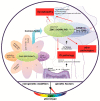Prenatal Zinc Deficient Mice as a Model for Autism Spectrum Disorders
- PMID: 35682762
- PMCID: PMC9181257
- DOI: 10.3390/ijms23116082
Prenatal Zinc Deficient Mice as a Model for Autism Spectrum Disorders
Abstract
Epidemiological studies have shown a clear association between early life zinc deficiency and Autism Spectrum Disorders (ASD). In line with this, mouse models have revealed prenatal zinc deficiency as a profound risk factor for neurobiological and behavioral abnormalities in the offspring reminiscent of ASD behavior. From these studies, a complex pathology emerges, with alterations in the gastrointestinal and immune system and synaptic signaling in the brain, as a major consequence of prenatal zinc deficiency. The features represent a critical link in a causal chain that leads to various neuronal dysfunctions and behavioral phenotypes observed in prenatal zinc deficient (PZD) mice and probably other mouse models for ASD. Given that the complete phenotype of PZD mice may be key to understanding how non-genetic factors can modify the clinical features and severity of autistic patients and explain the observed heterogeneity, here, we summarize published data on PZD mice. We critically review the emerging evidence that prenatal zinc deficiency is at the core of several environmental risk factors associated with ASD, being mechanistically linked to ASD-associated genetic factors. In addition, we highlight future directions and outstanding questions, including potential symptomatic, disease-modifying, and preventive treatment strategies.
Keywords: ASD; MIA; Shank3; autism; biometals; copper; mouse models; synaptopathy; trace metals.
Conflict of interest statement
The authors declare no conflict of interest.
Figures



Similar articles
-
Shank3 Transgenic and Prenatal Zinc-Deficient Autism Mouse Models Show Convergent and Individual Alterations of Brain Structures in MRI.Front Neural Circuits. 2019 Feb 22;13:6. doi: 10.3389/fncir.2019.00006. eCollection 2019. Front Neural Circuits. 2019. PMID: 30853900 Free PMC article.
-
Immune activation during pregnancy exacerbates ASD-related alterations in Shank3-deficient mice.Mol Autism. 2023 Jan 5;14(1):1. doi: 10.1186/s13229-022-00532-3. Mol Autism. 2023. PMID: 36604742 Free PMC article.
-
P2X7 Receptors Drive Poly(I:C) Induced Autism-like Behavior in Mice.J Neurosci. 2019 Mar 27;39(13):2542-2561. doi: 10.1523/JNEUROSCI.1895-18.2019. Epub 2019 Jan 25. J Neurosci. 2019. PMID: 30683682 Free PMC article.
-
Autism Spectrum Disorder: Neurodevelopmental Risk Factors, Biological Mechanism, and Precision Therapy.Int J Mol Sci. 2023 Jan 17;24(3):1819. doi: 10.3390/ijms24031819. Int J Mol Sci. 2023. PMID: 36768153 Free PMC article. Review.
-
Comparison of SHANK3 deficiency in animal models: phenotypes, treatment strategies, and translational implications.J Neurodev Disord. 2021 Nov 16;13(1):55. doi: 10.1186/s11689-021-09397-8. J Neurodev Disord. 2021. PMID: 34784886 Free PMC article. Review.
Cited by
-
NMDA Receptors in Neurodevelopmental Disorders: Pathophysiology and Disease Models.Int J Mol Sci. 2024 Nov 18;25(22):12366. doi: 10.3390/ijms252212366. Int J Mol Sci. 2024. PMID: 39596430 Free PMC article. Review.
-
Glyphosate as a direct or indirect activator of pro-inflammatory signaling and cognitive impairment.Neural Regen Res. 2024 Oct 1;19(10):2212-2218. doi: 10.4103/1673-5374.391331. Epub 2023 Dec 21. Neural Regen Res. 2024. PMID: 38488555 Free PMC article.
-
Examining Prenatal Dietary Factors in Association with Child Autism-Related Traits Using a Bayesian Mixture Approach: Results from 2 United States Cohorts.Curr Dev Nutr. 2023 Jul 25;7(8):101978. doi: 10.1016/j.cdnut.2023.101978. eCollection 2023 Aug. Curr Dev Nutr. 2023. PMID: 37600935 Free PMC article.
-
Gestational hypothyroxinemia induces ASD-like phenotypes in behavior, proinflammatory markers, and glutamatergic protein expression in mouse offspring of both sexes.Front Endocrinol (Lausanne). 2024 May 1;15:1381180. doi: 10.3389/fendo.2024.1381180. eCollection 2024. Front Endocrinol (Lausanne). 2024. PMID: 38752179 Free PMC article.
-
Zinc signaling controls astrocyte-dependent synapse modulation via the PAF receptor pathway.J Neurochem. 2025 Feb;169(2):e16252. doi: 10.1111/jnc.16252. Epub 2024 Oct 25. J Neurochem. 2025. PMID: 39450676 Free PMC article.
References
-
- Huguet G., Benabou M., Bourgeron T. The Genetics of Autism Spectrum Disorders. In: Sassone-Corsi P., Christen Y., editors. A Time for Metabolism and Hormones. Springer; Cham, Switzerland: 2016. pp. 101–129. - PubMed
-
- Kelleher R.J., III, Geigenmüller U., Hovhannisyan H., Trautman E., Pinard R., Rathmell B., Carpenter R., Margulies D. High-throughput sequencing of mGluR signaling pathway genes reveals enrichment of rare variants in autism. PLoS ONE. 2012;7:e35003. doi: 10.1371/journal.pone.0035003. - DOI - PMC - PubMed
Publication types
MeSH terms
Substances
LinkOut - more resources
Full Text Sources
Medical

